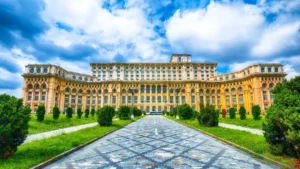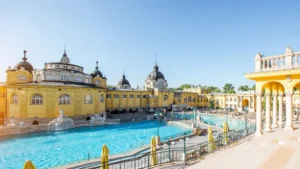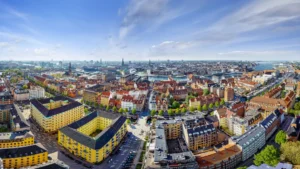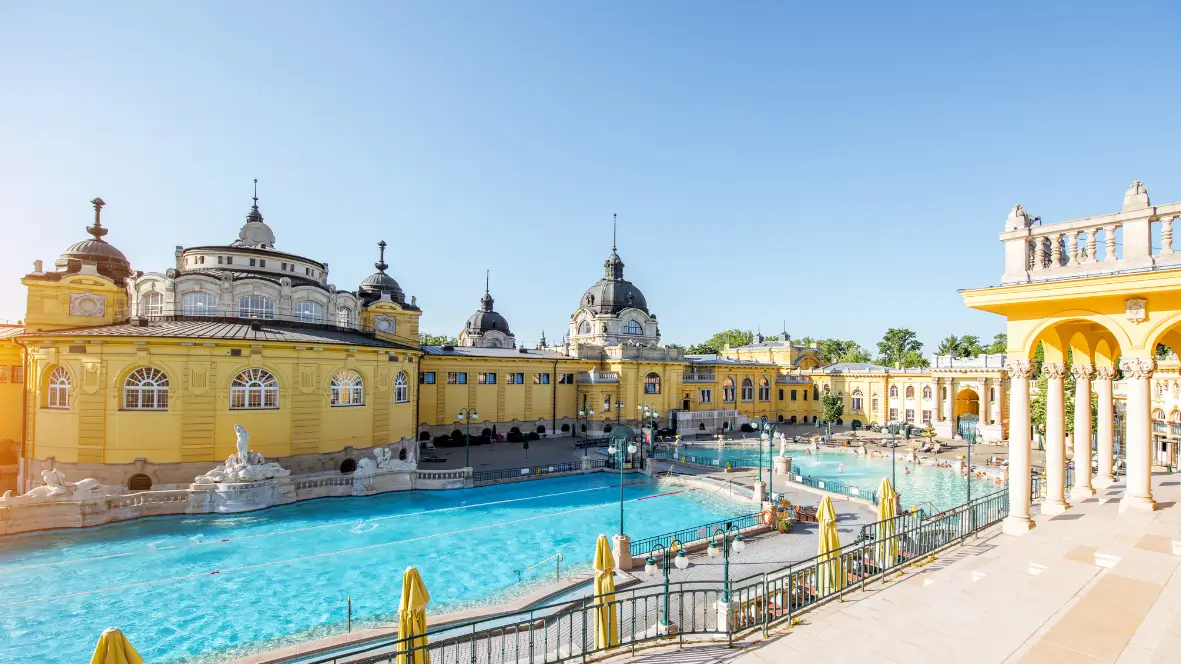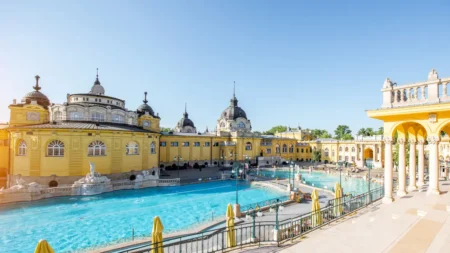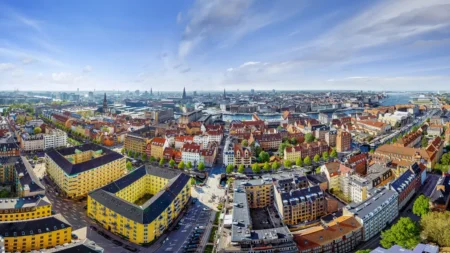Welcome to Budapest, a city where history meets modernity and culture thrives at every corner. From its architectural wonders to its renowned thermal baths, we’ll dive in and explain what makes Budapest such an unforgettable destination.
Table of Contents
Budapest: A Brief History
Budapest, the capital of Hungary, has a rich history dating back to ancient times. Originally a Celtic settlement, it became the Roman city of Aquincum in the 1st century AD. After the Romans, various tribes, including the Huns and Avars, occupied the region. In the 9th century, the Magyars arrived, founding the basis of Hungary under Árpád.
The modern city of Budapest was formed in 1873 by merging Buda, Pest, and Óbuda. The 19th century saw significant growth, especially after the Austro-Hungarian Compromise of 1867, making it a co-capital of the Dual Monarchy. Iconic structures like the Parliament Building and Chain Bridge were built during this time.
The 20th century brought wars and Soviet occupation, with notable events like the 1956 Hungarian Revolution. Since 1989, Budapest has transformed into a vibrant European capital known for its historic architecture, thermal baths, and cultural scene.
Top 9 Attractions in Budapest
Budapest boasts a plethora of iconic attractions that should not be missed. Here are the top nine:
- Buda Castle: A historic palace complex offering panoramic views of the city.
- Parliament Building: An architectural masterpiece situated along the Danube River.
- Fisherman’s Bastion: A fairy-tale-like terrace with stunning views of the city and river.
- St. Stephen’s Basilica: A magnificent church named after Hungary’s first king.
- Széchenyi Thermal Bath: One of the largest and most popular thermal baths in Europe.
- Heroes’ Square: A monumental square celebrating Hungarian history.
- Great Market Hall: A bustling market offering local produce, crafts, and food.
- Margaret Island: A serene island park perfect for relaxation and recreation.
- Gellért Hill: Offers breathtaking views and houses the historic Citadella.
A 3-Day Itinerary for Budapest
To help you make the most of your visit, here is a suggested 3-day itinerary:
Day 1: Explore the Buda side with a visit to Buda Castle, Fisherman’s Bastion, and Matthias Church. End the day with a relaxing soak in the Gellért Thermal Bath.
Day 2: Discover the Pest side by touring the Parliament Building, St. Stephen’s Basilica, and the Hungarian State Opera House. Spend the evening at Heroes’ Square and City Park.
Day 3: Start with a visit to the Great Market Hall, followed by a stroll along Andrássy Avenue. In the afternoon, unwind at the Széchenyi Thermal Bath and enjoy the nightlife in the Jewish Quarter.
Art Galleries in Budapest
Budapest is a haven for art enthusiasts, offering a variety of galleries that showcase both classical and contemporary works. Notable galleries include the Hungarian National Gallery, located in Buda Castle. This gallery houses a vast collection of Hungarian art from the Middle Ages to the present, including must-see masterpieces like “The Sermon” by Mihály Munkácsy.
The Ludwig Museum focuses on contemporary art, featuring works by both Hungarian and international artists. It provides a vibrant mix of modern art that reflects current trends and global influences.
The Koller Gallery, the oldest private gallery in Hungary, specializes in modern and contemporary art. It offers a unique perspective on the evolution of Hungarian art and its place within the broader European context.
Churches in Budapest
Budapest is home to numerous beautiful churches that reflect its rich religious heritage. Some of the most notable ones are St. Stephen’s Basilica, renowned for its impressive dome and stunning interior; Matthias Church, a Gothic masterpiece located in the heart of the Castle District; and the Great Synagogue, the largest synagogue in Europe, known for its striking Moorish Revival architecture.
Matthias Church: Located in the Buda Castle District, Matthias Church is a Gothic marvel dating back to the 14th century. It features a beautiful diamond-patterned roof and houses the Ecclesiastical Art Museum, showcasing sacred relics and medieval carvings. The church’s stunning frescoes and stained glass windows are highlights of its intricate interior.
Great Synagogue: Situated on Dohány Street, the Great Synagogue is the largest in Europe, with its Moorish Revival architecture inspired by Islamic motifs. It includes the Jewish Museum, which narrates the history of Hungarian Jewry, and the Holocaust Memorial, commemorating Holocaust victims with a weeping willow sculpture.
Districts and Zones of Budapest
Budapest is divided into 23 districts, each with its own unique charm and attractions. Key districts to explore include:
Castle District: Home to Buda Castle and historic sites, this district offers a journey through Budapest’s royal past. Visit the Buda Castle and enjoy panoramic views of the city from the Fisherman’s Bastion.
Belváros-Lipótváros: This central district features the Parliament Building and St. Stephen’s Basilica. Tour the Hungarian Parliament Building and marvel at its stunning architecture and rich history.
Jewish Quarter: Known for its vibrant nightlife and cultural landmarks, including the Great Synagogue. Explore the ruin bars, especially Szimpla Kert, and experience the unique nightlife of Budapest.
Budapest’s Thermal Baths
Budapest is famous for its thermal baths, thanks to the natural hot springs beneath the city. These baths are an integral part of Hungarian culture, offering both relaxation and social interaction. The tradition of bathing dates back to Roman times and was further developed during the Turkish occupation in the 16th century, making it a deeply rooted custom in Budapest.
Széchenyi Thermal Bath: Known for its grand Neo-Baroque architecture and extensive facilities, Széchenyi is one of the largest thermal bath complexes in Europe. It’s a popular spot for both locals and tourists to unwind and enjoy the therapeutic benefits of the mineral-rich waters.
Gellért Thermal Bath: Renowned for its Art Nouveau design, Gellért offers a serene and luxurious bathing experience. Its therapeutic waters are believed to help with a variety of ailments, making it a favored destination for health-conscious visitors.
Rudas Thermal Bath: This bath offers a unique mix of traditional Turkish baths and modern wellness amenities. Its historical significance and panoramic rooftop pool make it a must-visit. The Turkish bath features have been preserved from the 16th century, providing a glimpse into Budapest’s rich history.
Historical Buildings in Budapest
Hungarian Parliament Building: This iconic structure is a prime example of Gothic Revival architecture, characterized by its pointed arches, intricate detailing, and dramatic vertical lines. Completed in 1904, the design was inspired by the Houses of Parliament in London, incorporating unique Hungarian elements. The building’s spires and ornate façade are striking features.
Buda Castle: Overlooking the city from Castle Hill, Buda Castle has been a symbol of Hungary’s royal history for centuries. Originally built in the 13th century, it showcases a blend of medieval, Baroque, and modernist styles due to numerous reconstructions. Today, it houses the Hungarian National Gallery and the Budapest History Museum.
Chain Bridge: Opened in 1849, the Chain Bridge was the first permanent bridge to span the Danube River, connecting Buda and Pest. Designed by English engineer William Tierney Clark and supervised by Scottish engineer Adam Clark, the bridge is an engineering marvel of the 19th century, marking a significant development in the unification of the two cities.
Cuisine of Budapest
Hungarian cuisine offers a rich variety of traditional dishes that are essential to try in Budapest. At the heart of this culinary experience is Goulash, a hearty soup made with beef, vegetables, and paprika. It’s best enjoyed with fresh bread to soak up the savory broth.
Another popular street food is Lángos, a deep-fried dough topped with sour cream, cheese, and garlic. For those with a sweet tooth, Chimney Cake (kürtőskalács) is a must-try. This sweet pastry is baked on a cylindrical spit and rolled in sugar and cinnamon, resulting in a crispy exterior and soft interior.
Chicken Paprikash features tender chicken in a creamy paprika sauce, typically served with Hungarian dumplings or rice. For a spicy kick, try Fisherman’s Soup (Halászlé), a fish soup flavored with paprika, popular along the Danube and Tisza rivers.
Try out Dobos Torte, a layered sponge cake with chocolate buttercream and caramel, and Stuffed Cabbage (Töltött Káposzta), cabbage leaves filled with pork, beef, rice, and spices in tomato sauce. To round off a meal, enjoy Pálinka, a traditional fruit brandy made from various fruits.
Outdoor Activities in Budapest
Budapest offers a wealth of outdoor activities for nature lovers and adventure seekers. Cycling along the Danube is a popular way to enjoy the scenic riverfront, with well-maintained paths offering views of landmarks like the Parliament Building and Buda Castle.
For hiking enthusiasts, the Buda Hills provide numerous trails with varying difficulty levels. A hike up Gellért Hill rewards with panoramic views of the city, while János Hill offers a peaceful retreat in nature.
Margaret Island is perfect for a relaxing day outdoors, with options for biking, picnicking, and boating. Rent a rowboat or pedal boat to explore the island’s serene waters and enjoy its gardens and attractions.
City Park (Városliget) also offers vast open spaces, ideal for picnicking, jogging, or leisurely strolls. For the more adventurous, rock climbing at Róka-hegy or exploring the caves of Pálvölgyi and Szemlőhegyi provide thrilling experiences.
Nightlife in Budapest
Budapest comes alive at night with a vibrant nightlife scene. Ruin Bars like Szimpla Kert, set in abandoned buildings with eclectic decor, offer a unique mix of art, music, and lively atmosphere. These bars have become iconic, providing memorable experiences for visitors.
For dancing and live music, clubs and dance halls such as Akvárium Klub and Instant-Fogas are excellent choices with great music and spacious dance floors. Live music venues like A38 and Budapest Jazz Club host performances from local and international acts, perfect for music lovers seeking quality live shows.
The Jewish Quarter is a nightlife hotspot with numerous bars, pubs, and clubs. It buzzes with activity late into the night, offering everything from craft beer pubs to elegant cocktail bars. For a more laid-back evening, wine bars across the city offer a chance to sample Hungary’s famous wines in a relaxed setting.
Culture and Customs of Budapest
People in Budapest generally dress smartly, especially for dining out or cultural events. In religious sites, maintain a respectful demeanor by speaking quietly and dressing modestly, covering shoulders and knees.
Tipping is appreciated but not mandatory; a 10-15% tip is customary in restaurants. Politeness and formal greetings are important, particularly when meeting someone for the first time. Close friends may greet with a kiss on each cheek, but personal space is respected.
Getting Around Budapest
Public Transport: Options include buses, trams, and metro lines. The metro system, with four lines covers most of the city and connects key areas. Trams, like the scenic Line 2 along the Danube, and buses provide comprehensive coverage, making it simple to get around.
Cycling: Budapest is increasingly bike-friendly, with dedicated bike lanes and rental services like MOL Bubi. Cycling along the Danube or through the city’s parks is a delightful way to explore Budapest.
Walking: Many attractions are within walking distance of each other, especially in central areas like District V (Belváros-Lipótváros) and the Castle District. Walking allows you to fully appreciate the city’s ambiance and historical architecture.
Taxis and Ride-Sharing: Taxis are widely available, and ride-sharing services like Bolt and Uber operate in the city, offering convenient options for getting around.
Boats: The Danube River runs through Budapest, and several boat services offer scenic transportation options, including regular ferries and sightseeing cruises.
Trains: For trips beyond the city, Budapest’s railway stations, including Keleti, Nyugati, and Déli, connect you to other Hungarian cities and international destinations.
Weather in Budapest
Spring – March to May: Mild temperatures and flora comes to life.
Summer – June to August: Warm and sunny, ideal for outdoor activities.
Autumn – September to November: Cooler temperatures and colorful foliage.
Winter – December to February: Cold with occasional snowfall, perfect for thermal baths.
Key Takeaways
- Budapest is a city where history meets modernity with architectural wonders, thermal baths, exquisite cuisine, and vibrant art galleries.
- The city has a rich history from ancient times, significant 19th-century growth, and transformation into a vibrant European capital after 1989.
- Must-see attractions include Buda Castle, Parliament Building, Fisherman’s Bastion, St. Stephen’s Basilica, Széchenyi Thermal Bath, Heroes’ Square, Great Market Hall.
- A suggested 3-day itinerary covers both Buda and Pest sides, featuring historical sites, cultural landmarks, thermal baths, and local cuisine.
- Budapest boasts numerous art galleries like the Hungarian National Gallery, Ludwig Museum, and Koller Gallery, showcasing classical and contemporary works.
- The city is home to beautiful religious sites like St. Stephen’s Basilica, Matthias Church, and the Great Synagogue, reflecting its rich religious heritage.
- Budapest is famous for its thermal baths, with Széchenyi, Gellért, and Rudas offering relaxation and therapeutic benefits.
- The city’s vibrant nightlife includes unique ruin bars, live music venues, and a variety of clubs and pubs, especially in the Jewish Quarter.


